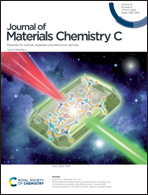Seed/ligand-cooperative growth of dense Au nanospikes on magnetic microparticles for SERS applications†
Abstract
Magnetic/plasmonic microparticles have attracted considerable attention because of their integrated magnetic manipulation and SERS sensing characteristics. However, traditional growth routes often lead to a compact or an irregular plasmonic shell with sparse hotspots, giving rise to low SERS sensitivity. Herein, we developed a seed/ligand-cooperative growth strategy to construct dense Au nanospikes on magnetic microparticles. By using Ag nanoparticle-modified magnetic microparticles as a template, a smooth Au seed layer was first created on magnetic microparticles through Dopa-mediated heterogeneous deposition; meanwhile the Ag+ ions released from the magnetic template generated Dopa–Ag+ capping ligands in situ around the Au seed layer. In such circumstances, the Dopa–Ag+ capping ligands guided all Au seeds to grow synchronously, which thus led to the formation of dense Au nanospikes on magnetic microparticles. Due to the abundant hotspots and magnetic responses, the prepared magnetic Au microparticles demonstrated excellent SERS sensitivity toward crystal violet with a detection limit of 10 pM. Furthermore, they exhibited fast detection of trace thiram in various complex samples like lake water, juice and soil with concentrations as low as 1 nM.

- This article is part of the themed collection: Journal of Materials Chemistry C HOT Papers


 Please wait while we load your content...
Please wait while we load your content...